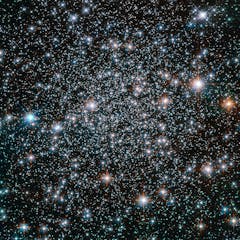
Articles on Space
Displaying 381 - 400 of 749 articles

There is a massive black hole in the center of the Milky Way galaxy. Measurements of star orbits near this black hole suggest that there may be a second companion black hole nearby.

Young readers ask: How did our moon get its name?

Little bits of Jupiter’s Great Red Spot seem to be flaking off. Is it a sign of the demise of this enigmatic red cloud, or just a consequence of atmospheric chaos we can’t see from above?

India may soon follow in the footsteps of Asian space giants China and India, after the National Institute of Aeronautics and Space (LAPAN) announced a plan to build a spaceport in Papua.

Somewhere out there, just maybe, an alien – probably stranger looking than in our wildest imagination – might be pondering this very question.

There’s really no reason you can’t use binoculars to look into space – and in fact astronomers have been working on doing so for a long time.

Apollo 11 tends to steal the spotlight when it comes to lunar landings. But Apollo 12 was the first mission to make a precise pinpoint landing on the Moon - and without the aid of computers or GPS.

Dark sky sites can inspire new generations of stargazers, but a better long-term solution would be connecting people with the night sky where they live.

Beyond the outer edge of the Solar System, mysterious, unknown worlds await by the thousands. Astronomers can now finally find them and explore them - but will we find another Earth?

Although it has yet to fly any paying passengers and is currently loss making, Virgin Galactic aims to be profitable by 2021.

Following announcements by France and the US, NATO is expected to start using space weapons.

Stars begin their life inside very large, fluffy clouds of space dust and gas called nebulae.

Scientists who discovered planets in far off stellar systems and the fundamentals of the Big Bang Theory have earned the 2019 Nobel Prize in Physics.

The opportunities in space are limitless. But without a sustainable approach to the space industry, our ability to exploit them won’t be.

A giant exomoon hundreds of times the size of Earth is revealing secrets about how giant planets like Jupiter and Saturn formed. They might also help astronomers find planets where life may thrive.

The first Martian might just be a human being.

The Universe is mind-bogglingly large and with the latest technology, the search is only just starting to heat up.

Kepler-452b is sometimes called ‘Earth 2.0’, but there’s a lot we still don’t know about it.

The International Space Station is the biggest human made structure in space and the third brightest object in the sky. But the living conditions for the six astronauts on it are quite cramped.

The constant pressure of gravity affects our thoughts and perception, but it’s so constant we haven’t noticed – until now.





